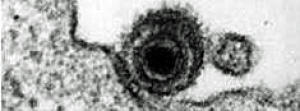
EB病毒感染B细胞(图)
EB病毒(Epstein-Barr virus, EBV)是Epstein和Barr于1964年首次成功地将Burkitt非洲儿童淋巴瘤细胞通过体外悬浮培养而建株,并在建株细胞涂片中用电镜观察到疱疹病毒颗粒。
EB病毒仅能在B淋巴细胞中增殖,可使其转化,能长期传代。被病毒感染的细胞具有EBV的基因组,并可产生各种抗原。EB病毒长期潜伏在淋巴细胞内,以环状DNA形式游离在胞浆中,并整合在染色体内。
EB病毒在人群中广泛感染,根据血清学调查,我国3~5岁儿童EB病毒VCA-lgG抗体阳性率达90%以上,幼儿感染后多数无明显症状,或引起轻症咽炎和上呼吸道感染。青年期发生原发感染,约有50%出现传染性单核细胞增多症。主要通过唾液传播,也可经输血传染。EB病毒在口咽部上皮细胞内增殖,然后感染B淋巴细胞,这些细胞大量进入血液循环而造成全身性感染。并可长期潜伏在人体淋巴组织中,当机体免疫功能低下时,潜伏的EB病毒活化形成得复发感染。
近日,丹麦首都哥本哈根的科学家首次发现了在EB疱疹病毒感染人类和引起免疫系统癌变过程中,一种特殊的受体(生物信号分子)起着关键性的作用。并且他们通过使用一种设计合成的微小生化分子,成功阻断了该受体,为有效的调控免疫系统中的记忆性B细胞提供了可能。
该研究的论文发表在最新一期的《Journal of Biological Chemistry》杂志上。
当病毒侵入人体时,科学家们观察到B细胞中一种特殊生物信号的过量表达,是名为EB12的受体,它们会迅速在B细胞表面上调表达。但出现这种现象的分子机制仍不清楚。
该大学保健科学部的博士后Tau Benned-Jensen 说道:“这些大量的EB12受体的表达很有可能是B细胞对病毒的反应,是在和病毒感染进行抗争。另一种可能是EB病毒控制了B细胞,诱导表达了大量的EB12受体。但我们现在能肯定的是被EB病毒感染的B细胞表达的这些EB12受体会促使其以比通常更快速度的增殖,导致感染扩散迅速。”
之后该研究小组对这种生物信号分子进行了研究,并生产出世界首个可以结合EB12受体的小分子。它能通过有效结合EB12受体,阻断其行使发挥正常的功能。
Tau Benned-Jensen说道:“这种抑制作用也许可以用于帮助那些移植后的病人,如果我们能遏制病毒的繁殖,将能有效的避免免疫系统癌症的发生。另一方面,EV病毒也会引发一些自身免疫性疾病,所以它们也可得到有效控制。我们后期将会发现更多可用的这种生化小分子,以帮助新药物的开发。”(生物探索 Jun译)
生物探索推荐英文论文原文摘要:
Ligand Modulation of the Epstein-Barr Virus-induced Seven-transmembrane Receptor EBI2
The Epstein-Barr virus-induced receptor 2 (EBI2) is a constitutively active seven-transmembrane receptor, which was recently shown to orchestrate the positioning of B cells in the follicle. To date, no ligands, endogenously or synthetic, have been identified that modulate EBI2 activity. Here we describe an inverse agonist, GSK682753A, which selectively inhibited the constitutive activity of EBI2 with high potency and efficacy. In cAMP-response element-binding protein-based reporter and guanosine 5′-3-O-(thio)triphosphate (GTPγS) binding assays, the potency of this compound was 2.6–53.6 nM, and its inhibitory efficacy was 75%. In addition, we show that EBI2 constitutively activated extracellular signal-regulated kinase (ERK) in a pertussis toxin-insensitive manner. Intriguingly, GSK682753A inhibited ERK phosphorylation, GTPγS binding, and cAMP-response element-binding protein activation with similar potency. Overexpression of EBI2 profoundly potentiated antibody-stimulated ex vivo proliferation of murine B cells compared with WT cells, whereas this was equivalently reduced for EBI2-deficient B cells. Inhibition of EBI2 constitutive activity suppressed the proliferation in all cases. Importantly, the suppression was of much higher potency (32-fold) in WT or EBI2-overexpressing B cells compared with EBI2-deficient counterparts. Finally, we screened GSK682753A against an EBI2 mutant library to determine putative molecular binding determinants in EBI2. We identified Phe111 at position III:08/3.32 as being crucial for GSK682753A inverse agonism because Ala substitution resulted in a >500-fold decrease in IC50. In conclusion, we present the first ligand targeting EBI2. In turn, this molecule provides a useful tool for further characterization of EBI2 as well as serving as a potent lead compound.







